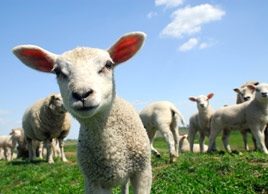Wool: New and improved
Eco-friendly wool has gone high-tech. Try it for a more comfortable (and itch-free) workout and a better night’s sleep

Source: Best Health Magazine, January/February 2009
It’s not your grandma’s wool
Knitted and woven fabrics made from the shorn coats of sheep have been around forever, but much of today’s new wool is not what you remember. “Everyone has a concept of their big woollen, itchy, too-hot sweater. They think: I’m allergic to it; it gives me a rash,” says Ralph Rossdeutscher, president and CEO of wool bedding manufacturer Natura World of Cambridge, Ont. But while scratchy sweaters are still around, he says, most of the wool products you’ll see today are made from selectively bred Australian and New Zealand merino sheep. This small breed’s coat is made up of fine, long strands that don’t itch (and few people are truly allergic to wool).
There are also innovations in the textile lab. In particular, a process called mercerization uses chemicals to remove “scales” of merino fibres that naturally exist on a strand of wool, making it both softer and machine washable, as the scales no longer catch on each other during a wash.
Retail trends
This winter, many mainstream retailers are well stocked with lightweight merino wool sweaters with a cashmere-like feel for $60 or less. Fashionable socks and tights that feel like spongy cotton cost around $20 and sell mainly in outdoors or sports stores.
A more surprising find at retailers is wool underwear—not itchy long johns, but cotton-like bikini panties and lightweight camisoles. Wool athletic shirts and stretchy pants (about $80) are the new alternative to synthetics. Wool batting is also replacing down and cotton as a filling for mattress covers, comforters and pillows—and sells for around the same price as down products.
The science of wool
Fine wool works well close to the skin. It keeps you either dry and cool, or dry and warm (just as it did for the sheep, no doubt). But, while cotton gets wet when you sweat and synthetics wick moisture from, say, your foot into your shoe, wool gets rid of the moisture. “The fibre breathes, and the fabric —or weave—of those fibres does, too,” says Robbie Stevens, director of sales and media relations for the Vancouver office of Icebreaker, a New Zealand-based activewear company. Wool takes moisture from your skin into the core of the fibre and then it evaporates, explains Stevens.
This fibre’s ability to regulate body temperature is the main reason an Australian study found that when people slept with a wool underlay instead of a down or synthetic one, they moved less and had a deeper sleep. And wool bedding makes it a good choice for those with a dust mite allergy. “Dust mites need moisture to thrive,” says Rossdeutscher, and because wool bedding wicks away moisture, it stays drier.
Wool also has environmental benefits. Sheep are shorn once a year—the process is painless and takes about two minutes—making it a renewable resource. (Compare this to down: The goose is often killed to make a duvet.) Also, wool products discarded in landfills will eventually decompose, unlike synthetics.
Wool isn’t perfect
• Moths like animal-derived fabrics, so consider storing wool clothing with cedar chips or mothballs.
• Animal rights groups such as PETA object to a technique called mulesing, used by some farmers, which involves cutting off part of the sheep’s backside to prevent infestation by a common parasite. (Almost all New Zealand farmers have phased out the practice, while Australia has pledged to do so by 2010.) As well, animal rights groups say merino sheep are treated cruelly during transport to the Middle East, where they’re slaughtered once their wool-bearing years are over.
• While the newer merino wool products feel great and do well in the washing machine—but should be hung to dry—read the label carefully. Unless it says otherwise, it will shrink in the wash.
This article was originally titled "Curious about the new wool?" in the January/February 2009 issue of Best Health Magazine. Subscribe today and never miss an issue!




